Many thanks, Roger -- the work of Francis Marshall is very much of interest to me and I'm sure most of this blog's readers feel the same way.
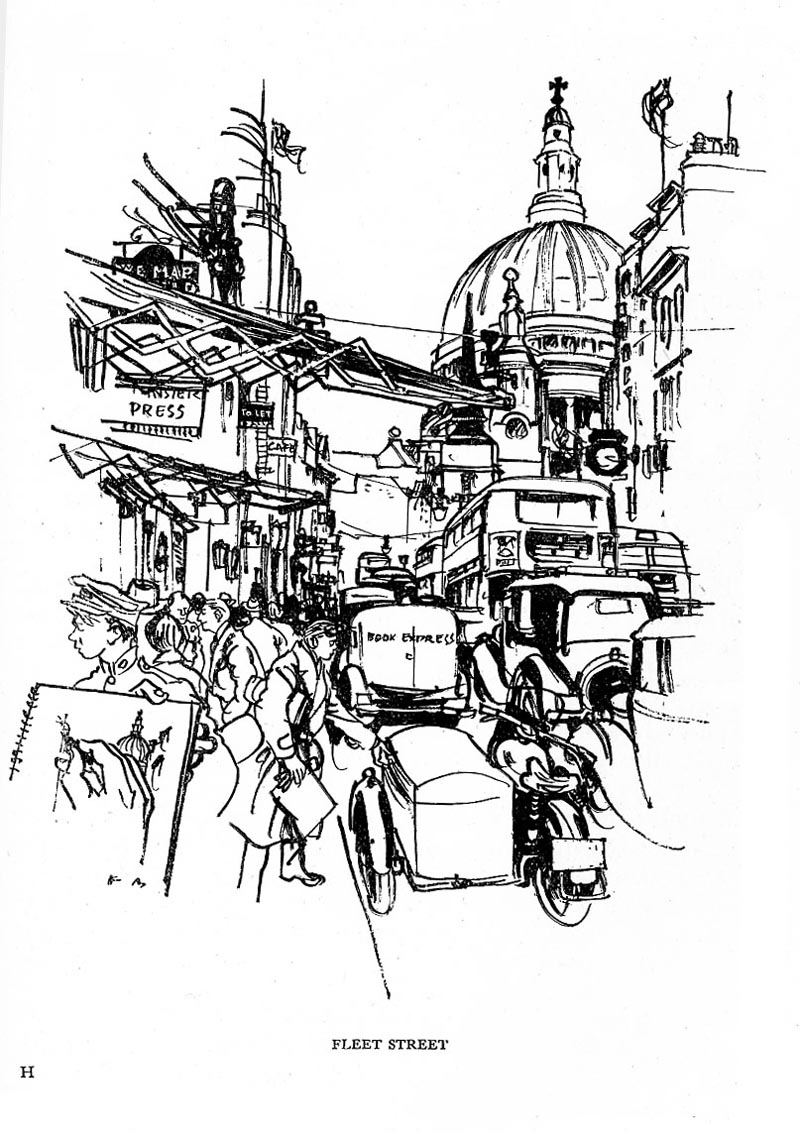
Roger enclosed a page that provided a bit of biographical information about the artist. Marshall studied at The Slade School (the same school Robert Fawcett attended) and subsequently began a career drawing advertising illustrations. In 1928 he began a ten year relationship with Condé Nast, working for Vogue magazine in London and Paris.
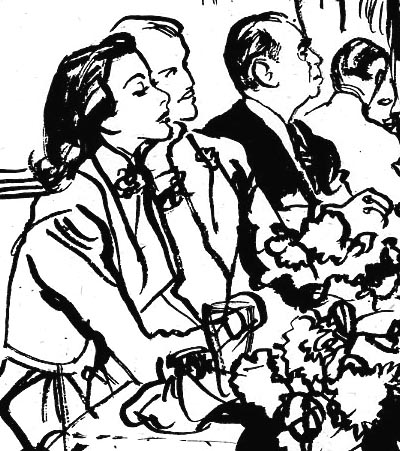
A quote from a publication called "The Sketch":
"Francis Marshall is a terrific worker and when away from his studio seldom travels without a sketch book; draws everything everywhere - 'An Englishman in New York' being the result of a visit to America."
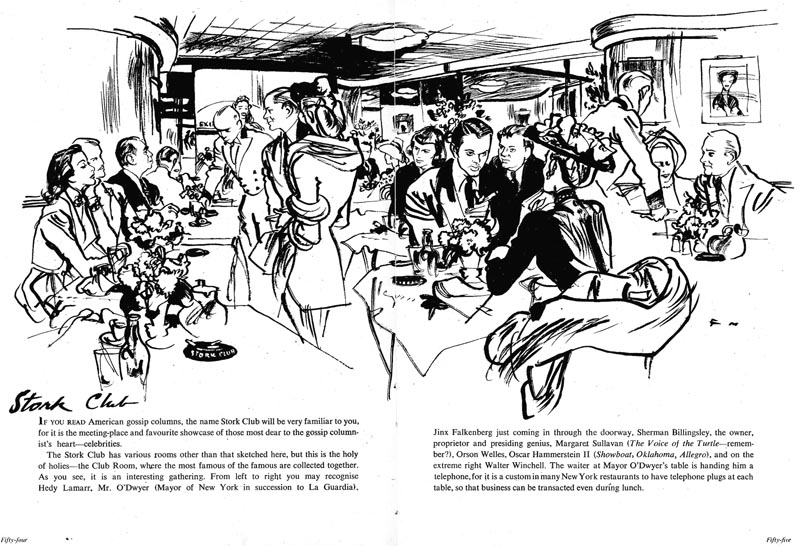
Marshall enjoyed sketching at the ballet at Covent Garden Opera House. "He can work under the greatest difficulties," writes the anonymous author, "he has been seen almost in darkness in a badly placed box sketching the elaborate trappings and mystical figure of Ram Gopal."
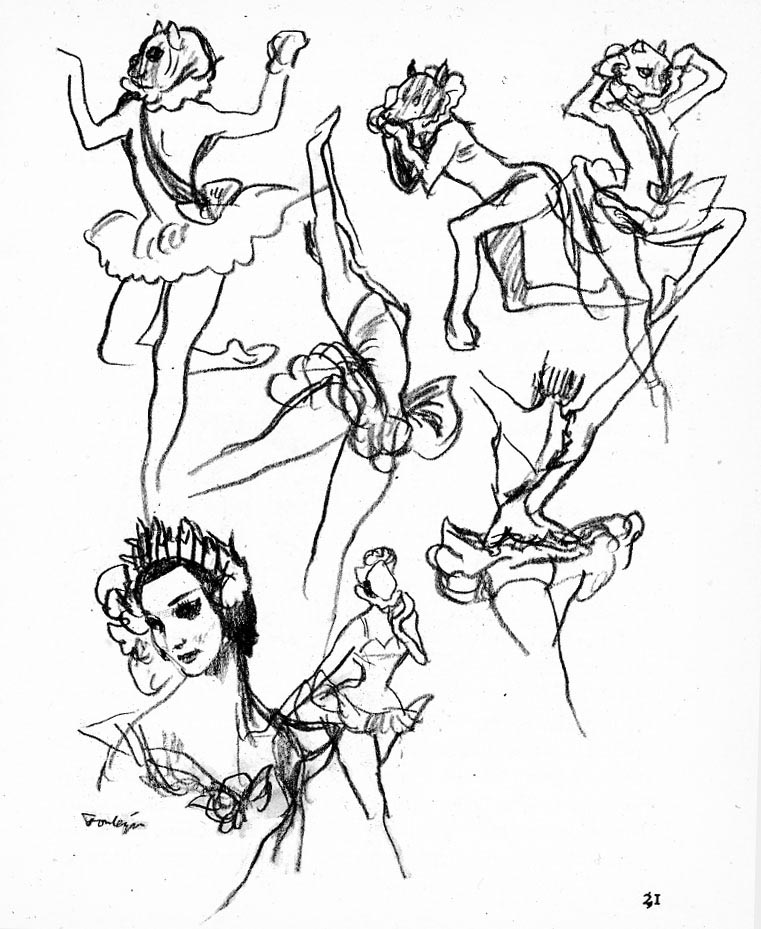
"Wherever he is, men and women of all types on their social workaday occasions, all are seen with a quick eye, rapidly sketched and added to his collection for future use."
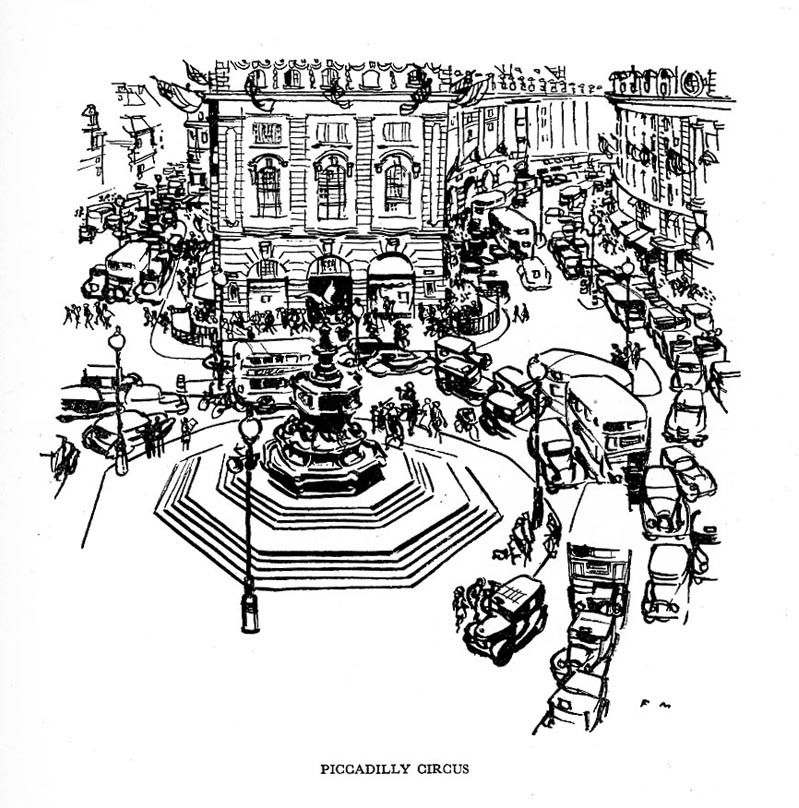
"Best of all," continues the author, "Francis Marshall likes drawing beautiful women and with the advent of more paper for the press, his weekly fashion feature has returned to the Daily Mail. He has a flair for dress and his women are always gowned in the best style."

"Drawing clothes so that people wearing them really look as though they have an intelligent appreciation of dress, is a natural gift for him. There is little doubt that future generations will turn to his drawings to see what we wore and how we looked at this point in history."
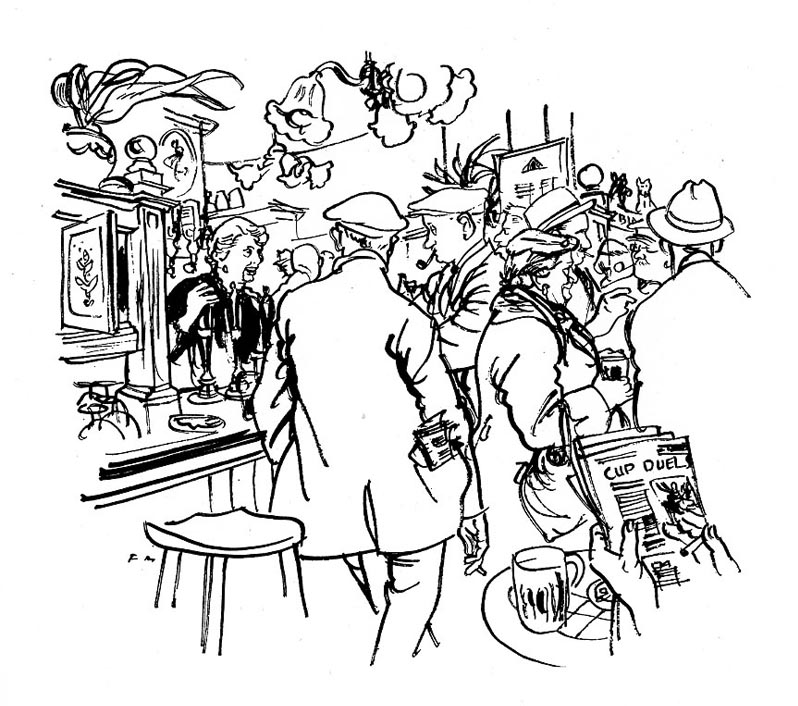
"England has produced some grand black-and-white artists... that in Marshall we have an artist in pen and ink equal to the best of them is not yet fully realised."
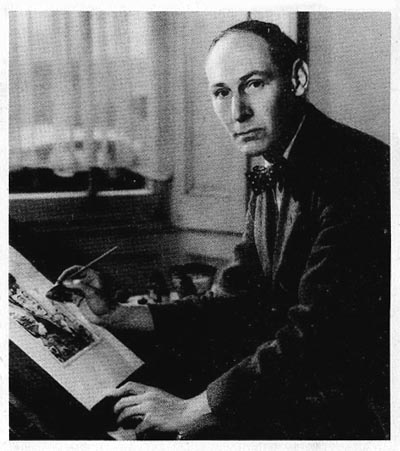
"There is the same close observation of the human race and the ability to get down on paper in black and white, the human characteristics of living people."
Many thanks to Roger O'Reilly for providing the art and information for this introduction to the work of Francis Marshall!
*My Francis Marshall Flickr set.
"The Sketch" was a popular tabloid newspaper in the UK through to the 1960s or 70s. This was before such newspapers turned into little more than gossip magazines obsessed with sex and celebrity!
ReplyDeleteGreat site - thanks for some great stuff over the years
Mike UK
Love Francis Marshall.A fashion illustrator but so much more.Great observation and compositional abilities,a lovely spontaneous line and so adept at capturing naturalistic gesture.Also his color work was very interesting,like Fawcett using a sinewy line drawing and then overlaying inks and opaques to add depth of color. Unfortunately totally ripped off by Barbara Cartland the weird romance authoress.
ReplyDeleteWhat fabulous drawings. They look so complete - they're lacking nothing in their simplicity - beautiful !
ReplyDeletehttp://barbaracartlandbooksandcoverart.blogspot.com/
ReplyDeleteChad may not like Cartland, but the covers that Francis Marshall illustrated are gorgeous. See my blog link.
i found the francis marshall book on magazine illustration at the strand bookstore about 15 years ago....great book,and i love his work....
ReplyDeleteGreat site Lief. I always love visiting. I loved many of these artist when I was a kid. I have one general question for you. Do you know how many of these artist used photography and photos to help them make their work? I am just curious because their work is so different from the past.
ReplyDeleteThanks
Tom
Mike; thanks for clarifying what "The Sketch" is - I really had no idea. Much appreciated - and for you kind words - thank you.
ReplyDeleteChad; beautifully put comments about Marshall's line. I'm not sure about the part about Barbara Cartland ripping him off though... are you under the impression that she painted the covers of her books and ripped off his style? Because from my understanding Marshall did the covers and she wrote the novels. Sorry, I'm confused by that last part...
Larry; I must agree. :^)
Rhonda; I'm planning on showcasing some of those covers one day this week and will include a link to your blog. Thanks for posting all those nice large scans!
Brian; That sounds like a great find. I never cease to be amazed by the treasures you've unearthed.
Tom; Thank you - I'm glad you've been enjoying the blog. Regarding the use of photo reference... I think it became the standard procedure among 1950's illustrators especially, although it seems quite a few used photos in the 40's as well. When the Polaroid camera was invented, I'm sure even more illustrators jumped on the photo ref. band wagon... but I suspect there were always some who worked strictly from life. I'm beginning to appreciate that among those with a background in fashion, this was especially the norm: Eric, Jack Potter, and now Francis Marshall, for example... all with a fashion connection, and all worked from the model - and 'on location'.
Thanks Lief
ReplyDeleteAlso have you posted on Haroald Von Schmidt or Peter Helick?
Thanks for the great blog
Tom
Tom;
ReplyDeleteNot yet - but they are both on my "To do" list :^)
leif....i just sent you 5 scans from the book "magazine illustration" by francis marshall....best,brian...
ReplyDeleteLeif
ReplyDeleteGreat to see there's such an interest in Marshall.
What I love about his work is his concentration on pose and character. For his "Englishman in New York" book, you would have expected countless renderings of the Empire State Building, Wall street and the usual landmarks. Instead it's a collection of observations of the people who live, work and play in the town. Any architectural landmarks take strictly second place and what we have instead is an impression of the environment of a particular place and period in time.
Rhonda ; great to see those covers. Hadn't come across many of them before.
No Leif,far worse.Cartland was a writer of zero technical merit whose formulaic romance novels were graced by Francis Marshall's beautiful covers.After publication she absolutely refused to allow Marshall to keep ANY of his original pictures (there were hundreds of them) and I'm not even sure he made anything on the reprints. She had them all framed and on the walls of her mansion and felt HE should be grateful for the chance to work with her!As I understand it both Francis Marshall and his wife were very bitter for the way he was exploited by the 'Queen of Romance'.I have some material on FM from the 2 Studio 'How to' fashion books he wrote if you're interested.
ReplyDeleteWow, Chad; That's a crazy story! Is this documented anywhere (not that I don't believe you, its just that I'd love to include a link to it or something when I show some of FM's Cartland covers). Please let me know if you can recall where you first read about this awful situation.
ReplyDelete*Whew!*
Not sure if there's anything online about this, I saw this story on TV over here in a feature about copywright issues relating to illustrator's original art; and then alluded to in an uncritical documentary about BC a couple of years ago.It was standard practice for publishers to keep all original art and illustrators feared 'making waves' in fear of being blackballed by art directors.
ReplyDeleteYeah, no surprise there... plenty of stories in N. America of artists not getting their artwork back. Well, this is fascinating... thanks for making us aware of this terrible abuse, Chad - I'll see if I can dig up any more on this.
ReplyDeleteLeif, that was a real "bummer" for me to try and get an original back, even to just make copies. Most A.D.'s would not return an illustration after it was reproduced, even though it might eventually be stored, and sometimes even tossed out, or end up hanging in an ad exec's home. I suspect clients would snag one now and then to personally keep if they wanted it, but the agencies attitude toward an illustrator was they purchased it, and it was no longer your property.. and that was an acceptable transaction. Some A.D.'s that were also good friends, didn't want to rock the boat with the agency by returning an illustration, and I understood that, but it was still disappointing.
ReplyDeleteSometime in the 70's, came the notion that illustrators should sell the "reproduction only rights" for one price, and if the agency or client wanted total ownership, they pay a bigger price. Eventually that became more common practice in the S.F. market, where I worked.
Tom Watson
Tom;
ReplyDeleteI had the same sort of experience in general in the late 80's and during the first half of the 90's. I will always remember feeling cheated when a client told me that a huge original I had done for a Heinz pasta tin of Batman swinging across a silhouetted skyline had been presented as a gift to some VP at Heinz, and that it was now hanging in his office (as if I should feel honoured about that!). No one asked me - and no extra compensation... though the giving of the "gift" was intended to (and likely did) benefit the design firm that had commissioned me to do the piece in the first place.
This sort of situation always made me feel resentful, but I never wanted to rock the boat for fear of losing them as a repeat client.
The advent of digital art has pretty much eliminated the issue of original art being returned, however I must give props to those agency art buyers who made a habit of returning originals. They were in the minority, but there were (and still are) some true professionals out there!
Chad is correct that Barbara Cartland has hundreds of Francis Marshall's illustrations framed in her home. I've seen pictures of them in a biography and her son has mentioned them to me.
ReplyDeleteWhether you like her work or not, the novels were definitely enhanced by the beautiful covers drawn by Marshall. See my link listed in my first post above to see pictures of some of them. Marshall did covers of roughly 200 of Cartland's novels and he did 2 covers of the same book for UK and US audiences! I am working on getting all of them online for viewers.
I've just come acros your feature on Francis Marshall, and I wonder if you know that when he died, Barbara Cartland was offeRing enormous sums to any artist who could produce cover illustrations like him - well, I suppose she thought it was a perfectly reasonable request. .(she wasn't !well known for her intelligence!) It' interesting to spot the artists who attempted it by whatever of their personality still showed through - I know a couple of names but I've been sworn to secrecy! (This really is true - her writing was so dreadful that they were both embarrassed, and didn't want anyone to know!) I think it,s possible to spot the "culprits" though by identifying what remains of their normal style. See if you agree with me. On another subject: you used to send me a "Today's inspiration pic several times a week, then you sent me a message saying "Did I want you to continue to do so?" I said "Coo! Yes please!" Whereupon you stopped sending 'em. What went wrong? Sincerely, ....Ron Tiner
DeleteI'm not too surprised. As someone who was buying Cartland's novels every month as they were being published, I'm sure she knew that the cover art enhanced her writing and sold books.
DeleteI was a reader, not an artist, but I instinctively was drawn to books with good cover art and artists such as Marshall, Allan Kass, and Walter Popp.
I was lucky to get a copy of "An Englishman in NY" today from Stuart Ng books. I also have "London West", but this book is just full of sketchbook drawings. A few of the LW illustrations betray their photo referenced origins I think. Wish I could draw like this.
ReplyDeleteI just came across your post on Francis Marshall. I was a college student in the 50 ies and was writing a study on Fashion Through the ages and I wrote to many of the fashion illustrators and designers at that time. FM sent me a lovely letter and one of his sketches seen Digital Gran: Francis Marshall
ReplyDeleteRe: the comments on Francis marshall and barbara Cartland - surely whether he got to keep pictures or whether he was paid for reprints etc was a matter between him and the publisher rather than barbara Cartland? and if thought himself poorly treated by her, why did he go on doing the covers?
ReplyDeleteGood point.
DeleteHe has a good hand and a marvelous sketches. Do you want to know how to tell if someone is listening to your mobile phone calls? Have a look here!
ReplyDeleteAny interest in purchasing original Francis Marshall pieces or know where o can sell them?
ReplyDelete